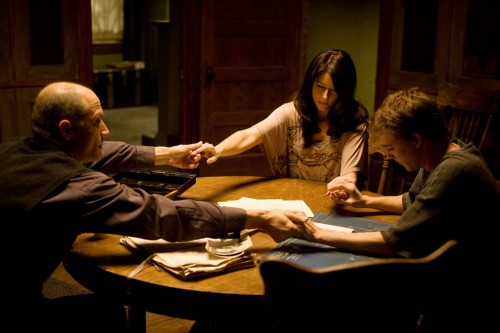The Haunting in Connecticut
The House the Warrens Built

Starring: Kyle Gallner, Virginia Madsen
By Tom Bevis
The house is dingy – every inch of floor covered in slime, every foot of wallpaper peeling in ugly green strips like dead skin. The windows bleed diluted yellow light, the floorboards creak, and you can’t walk into a room without something jumping out at you. All the while, Sara Campbell (Virginia Madsen) walks through the house, exclaiming: “it’s perfect!”
I imagine a similar thing happened with the script.. The dialog is stiff, the logic is forced and riddled with fallacies, and the story itself is packed with cheap rip-offs from numerous other horror movies. Yet, somewhere, a studio executive screamed into a bustling script pool: “this is perfect!”
But let’s look at this from level ground. This is a film that utilizes some sort of paranormal Freud as the mysterious villain, claims that ectoplasm can suddenly erupt from every orifice of a medium, and I’m not even going to ponder the importance of the strange Jason Voorhees claymation that’s imbedded into the film. This is a film that boasts itself to be true, yet insists we believe in the concept of necromancy (if you’re not a D&D buff, necromancy is magical power through control of the dead).
The film has everything to expect from a haunted house story. There is a priestly advocate, a set of teenagers that buckle up for a high-speed investigation, and there are clandestine discoveries abound: hidden mortician tools! Death photos! A box full of eyelids! There’s the battle between the vindictive spirit and the redemptive spirit, and the famed Amityville Axe even makes an appearance.
The writer attempts to pair these stock elements with others that are intended to be fresh and innovated but are too obscure or self-imposed to make a difference. Did you know, for instance, that iron bars aren’t used in prison to keep the prisoners locked up but rather to hold in their souls? And did you remember to keep your doors and windows open last time you had your house exorcised? That’s right, because, as the film claims, houses are not so much haunted as they are possessed.
It’s true, the script and the silly premise behind it are the film’s biggest problems. The effects were as good as any in its genre, and other than an over-reliance on stock footage of people running through a hallway, the editing and cinematography were adequate. The performances in this film were about as good as the script could call for. There is some trouble in the pacing. Unlike other ghost pictures, there is no escalation of events. The events go from typical to horrific in just a few seconds.
What irritates me the most about this film, and several others in its genre, is it’s ready and intense insistence that it’s based on true events. Like several others before, the filmmakers have confused the concepts of “based on true events” and “inspired on true events.” The case on which the film is based has spawned a television show (being the flagship episode for Discovery Channel’s “A Haunting”), a horror novel (Ray Garton’s “In a Dark Place”), and was perpetuated by the same duo who sensationalized the Amittyvile Horror case: Ed and Lorraine Warren.
So, because the scriptwriters and filmmakers took it on themselves to omit some of the nastier facts of the family plagued during this supposed haunting, please let me take a moment to even out the playing field. The parents of the family, shown here to be innocent onlookers trying desperately to keep their family together, were actually swingers with addictions to both drugs and alcohol. The central character was, essentially, a rogue teenager accused of raping his cousin and being addicted to drugs himself. And the perpetuators of claims of hauntings in the home? You got it. The Warrens , eager to replicate their success with the Amityville Horror. This is not a defamation of character. Rather, the film was an inaccurate display of righteousness.
“I don’t care if anyone believes me,” Madsen says as the film closes. “I just want people to know what happened here, that it can happen to good people.” The sad truth of the situation is, the family involved were not good people. And, if these people truly didn’t care about being believed, they never would have come out, they wouldn’t have changed their story repeatedly, and they wouldn’t have sold their story rights to create a novel, a television show, and a major motion picture.
1.5/5
